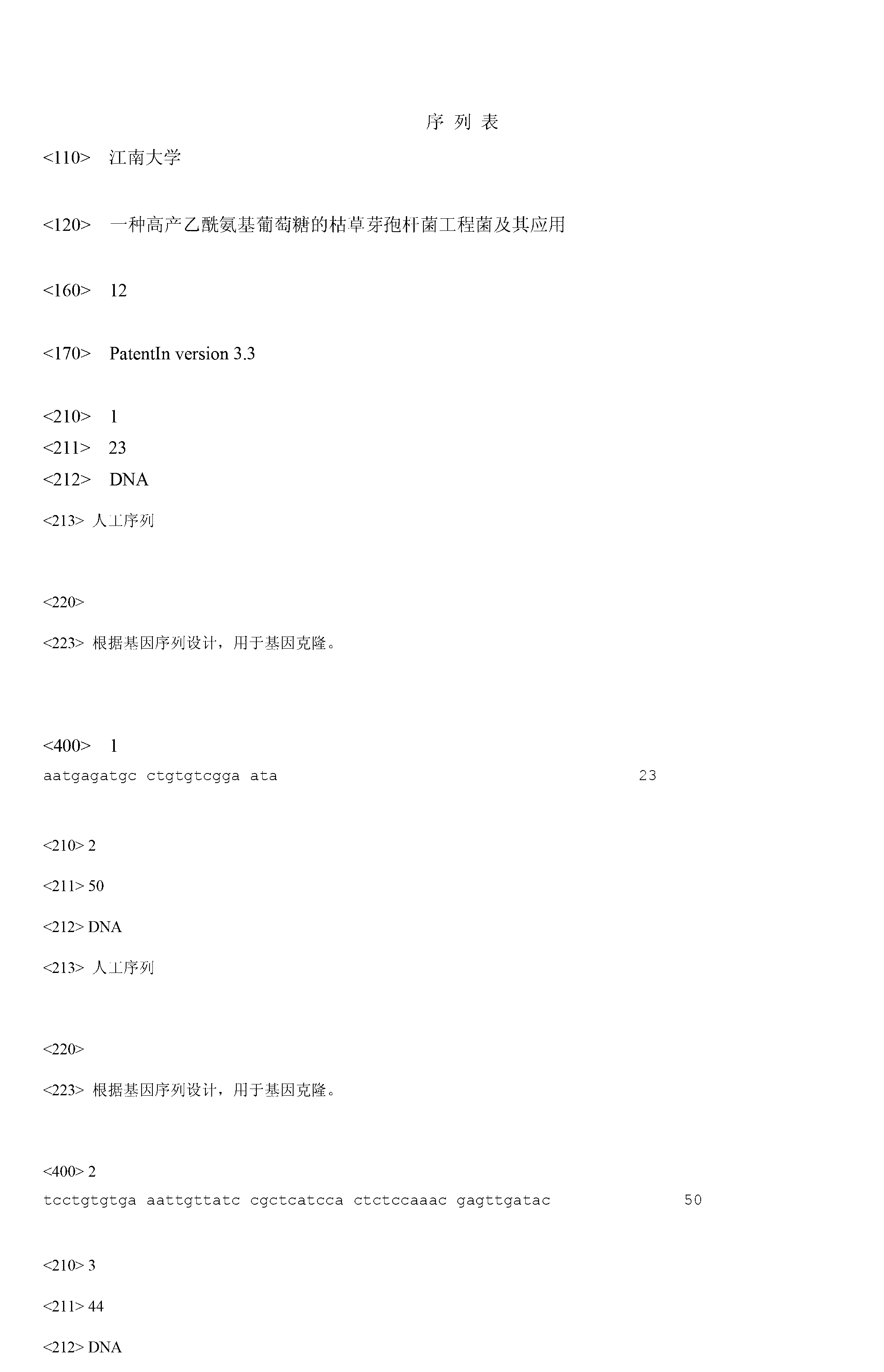Bacillus subtilis engineering bacteria with high yield of acetylglucosamine and application thereof
A technology of Bacillus subtilis and glucosamine, applied in the field of genetic engineering, can solve the problems of severe environmental pollution, unsuitable for people with seafood allergies, etc., and achieve the effect of simple construction method, convenient use, and good application prospects
- Summary
- Abstract
- Description
- Claims
- Application Information
AI Technical Summary
Problems solved by technology
Method used
Image
Examples
Embodiment 1
[0016] Example 1 Knockout of the gene encoding acetylglucosamine transporter (nagP)
[0017] According to the upstream and downstream sequences of the acetylglucosamine transporter gene (nagP) of Bacillus subtilis (Bacillus subtilis168, purchased from the American Type Microorganism Collection, ATCC No. 27370) published on NCBI, the homology arm amplification primers for the knockout frame were designed, The upstream and downstream primers of the left arm are: nagP-L-F: 5'-AATGAGATGCCTGTGTCGGAATA-3' and nagP-L-R:
[0018] 5'-TCCTGTGTGAAATTGTTATCCGCTCATCCACTCTCCAAACGAGTTGATAC-3'; the upper and lower primers of the right arm are: nagP-R-F:
[0019] 5'-ACGTCGTGACTGGGAAAACCCTGGCCGCGGTCTTAACCGGGTTA-3' and nagP-R-R:
[0020] 5'-TACGACAACGCCCAGCTTC-3'. The left and right arms of the nagP knockout box were amplified from the Bacillus subtilis168 genome using the above primers. According to the p7Z6 plasmid sequence published on NCBI (Nanjing Agricultural University, gifted by Dr. Y...
Embodiment 2
[0024] Example 2 Knockout of the gene encoding acetylglucosamine deacetylase (nagA) and the gene encoding acetylglucosamine deaminase (nagB)
[0025] The plasmid pTSC (Nanjing Agricultural University, gifted by Dr. Yan Xin, NCBI accession no.EU864234) was transformed into recombinant Bacillus subtilis that had knocked out nagP to eliminate bleomycin resistance. Since the gene encoding acetylglucosamine deacetylase (nagA) and the gene encoding acetylglucosamine deaminase (nagB) are in the same operon of the Bacillus subtilis (Bacillus subtilis168) genome, nagA can be knocked out simultaneously by a single homologous recombination and nagB two genes.
[0026] According to the upstream and downstream sequences of the Bacillus subtilis (Bacillus subtilis168) acetylglucosamine deacetylase coding gene (nagA) and acetylglucosamine deaminase coding gene (nagB) published on NCBI, the knockout frame homology arm amplification primers were designed, The left arm upstream and downstream ...
Embodiment 3
[0033]Example 3 Construction of acetylglucosamine-producing recombinant Bacillus subtilis
[0034] According to the glucosamine acetylase encoding gene (GNA1) in Saccharomyces cerevisiae S288C, purchased from the American Type Microorganism Collection, ATCC204508 published on NCBI, the primer GNA1-F was designed:
[0035] 5'-GGGGTACCATTATAGGTAAGAGAGGAATGTACACATGAGCTTACCCGATGGATTTTATA-3', GNA1-R: 5'-CCCAAGCTTCTATTTTCTAATTTGCATTTCCACG-3'. The gene encoding glucosamine acetylase (GNA1) was amplified from the Saccharomyces cerevisiae S288C genome using the above primers. The amplified fragment was digested with KpnI and HindIII and then ligated into the pP43NMK expression vector (kindly provided by Dr. Zhang Xiaozhou, Virginia Tech, USA). Restriction digestion and sequencing confirmed the successful construction of the recombinant plasmid pP43-GNA1.
[0036] The constructed expression vector pP43-GNA1 was transformed into Bacillus subtilis BSGN3. GNA1-F and GNA1-R primers were ...
PUM
 Login to View More
Login to View More Abstract
Description
Claims
Application Information
 Login to View More
Login to View More - R&D
- Intellectual Property
- Life Sciences
- Materials
- Tech Scout
- Unparalleled Data Quality
- Higher Quality Content
- 60% Fewer Hallucinations
Browse by: Latest US Patents, China's latest patents, Technical Efficacy Thesaurus, Application Domain, Technology Topic, Popular Technical Reports.
© 2025 PatSnap. All rights reserved.Legal|Privacy policy|Modern Slavery Act Transparency Statement|Sitemap|About US| Contact US: help@patsnap.com



